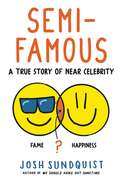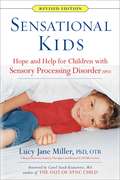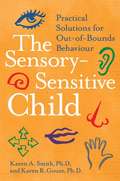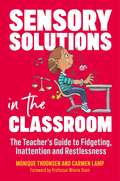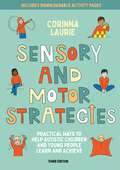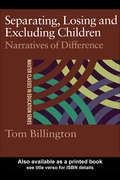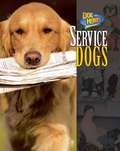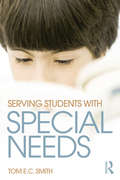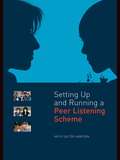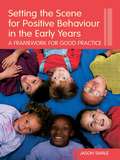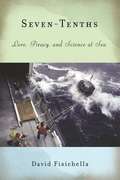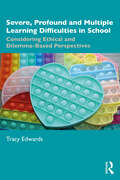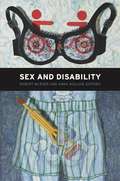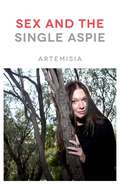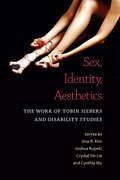- Table View
- List View
Semi-Famous: A True Story of Near Celebrity
by Josh SundquistIn this "laugh-out-loud funny&” book (Hank Green, New York Times bestselling author), social media star and comedian Josh Sundquist takes readers on his hilarious journey to the fringes of viral stardom to discover if it&’s possible to be both very famous and very happy As a semi-famous internet creator, Josh Sundquist knows what it's like to chase fame, but he also knows that more fame usually means more stress. So he set out on a pseudo-scientific investigation to find out if there is any way for fame and happiness to overlap. He attempts to define the word &“fame&”—hint: it's harder than you'd think. He turns back time to identify the first facially-recognizable celebrity (you might know his former BFF Brutus). He digs into the numbers to debunk urban legends associated with stardom (ever heard of the 27 Club?). He talks to other semi-famous people (from K-pop sensations to former child stars) and asks them: Is this fame thing making you happy? If not, why are you doing it? If so, what's your secret? All while recounting funny stories about his own cringy fame-seeking (like his many attempts, and failures, to get onto MTV). Packed with playful diagrams, fascinating insights from celebrities, and embarrassing truths from Josh&’s experience with semi-fame, this is a must-read for anyone who has ever dreamed of becoming famous…or at least going viral on TikTok.
Sensational Kids
by Lucy Jane MillerSensory Processing Disorder (SPD) is a condition affecting at least one in twenty children who experience sensations in taste, touch, sound, sight, smell, movement, and body awareness in a vastly different manner from how other children their ages do. What may be typical activities for most kids are a daily struggle that may result in social, emotional, or academic problems. Dr. Lucy Jane Miller, the best-known SPD researcher in the world, brings together a lifetime of study to teach parents and others the signs and symptoms of SPD and its four major subtypes; ways the disorder is diagnosed and treated; sensory strategies for living with the condition; and methods to help SPD kids thrive. .
Sensing the City: An Autistic Perspective
by Luke Beardon Sandra Beale-EllisHow do the sights, smells, and sounds of a city affect the senses of people with an Autism Spectrum Condition (ASC)? Sandra Beale-Ellis explores the sensory benefits and challenges of cities for people with an ASC and invites readers to understand the different ways in which they can experience a city from a sensory perspective. Sandra, who has been clinically diagnosed as having Asperger's Syndrome, describes how she experiences the city through the lens of ASC, picking up on things that a neurotypical (non-autistic) person might not. As well as introducing the wonders of the city that neurotypical people rarely see, this book also provides readers who have an ASC with solutions to the negative or overwhelming sensory experiences that a city can bring about. The book covers four main areas of city life: travel, eating out, entertainment and living.
Sensorcises: Active Enrichment for the Out-of-Step Learner
by Laurie GlazenerGet moving to prime the body for learning!All young students sometimes need a little extra help developing their senses. And many kids who are labeled as "problem students" simply lack the physical skills necessary to sit still, pay attention or even hold a pencil. Sensorcises helps students develop the very basic sensory skills needed for learning. Learn how to address the needs of these learners and help them develop the sensory motor skills they need to succeed.In this invigorating book, the author explores the REAL technique-Relax, Energize, Activate and Lead. By providing clear, step-by-step instructions, this book shows you how to design activity sequences to help students with sensory dysfunction as well as all the other learners in your K-5 classes. The author makes it incredibly easy to incorporate these exercises into any curriculum. Each research-based activity is fully described and illustrated with photographs to assist with classroom implementation.You AND your whole class will benefit from Sensorcises! They are the perfect way to boost energy levels while helping students focus their mind, body, and senses on achieving success.
Sensory Futures: Deafness and Cochlear Implant Infrastructures in India
by Michele Ilana FriednerRevealing inequalities and sensory hierarchies embedded in the latest medical technologies and global biotechnical marketsWhat happens when cochlear implants, heralded as the first successful bionic technologies, make their way around the globe and are provided by both states and growing private markets? As Sensory Futures follows these implants from development to domestication and their unequal distribution in India, Michele Ilana Friedner explores biotechnical intervention in the realm of disability and its implications for state politics in the Global South. A signing and speaking deaf bilateral cochlear implant user, Friedner weaves personal reflections into this fine-grained ethnography of everyday negotiations, activist aspirations, and the space of the family. She places sensory anthropology in conversation with disability studies to analyze how normative sensoria are cultivated and the pursuit of listening and speaking capability is enacted. She argues that the conditions of potentiality that have emerged through cochlear implantation have, in fact, resulted in ever narrower understandings of future life possibilities. Rejecting sensory hierarchies that privilege audition, Friedner calls for multisensory, multimodal, and multipersonal ways of relating to the world. Sensory Futures explores deaf people&’s desires to create habitable worlds and grapple with what their futures might look like, in India and beyond, amid a surge in both biotechnical interventions and disability rights activism. With implications for a broad range of disability experiences, this sensitive, in-depth research focuses on the specific experiences of deaf people, both children and adults, and the structural, political, and social possibilities offered by both biotechnological and social &“cures.&”
Sensory Issues for Adults with Autism Spectrum Disorder
by Luke Beardon Diarmuid HeffernanUnderstanding sensory issues can be the key to overcoming them. Using this practical guide, individuals with Autism Spectrum Disorders (ASDs) can begin to understand their sensory difficulties and learn how to create a tailored plan for overcoming specific everyday challenges. Learn how the senses work and how sensory systems can function differently for people with ASD, leading to sensory perceptual issues. What are the difficulties that can arise at work, college, home, or in public or cyber spaces? Practical strategies and creating a unique 'sensory plan', based on frequently encountered environments and situations, will help any adult with ASD to overcome these sensory difficulties.
Sensory Parenting for Sensory Children
by Tanya Van DalenWhen your child dysregulates, half the battle is managing your own response. In the moment, you're at the mercy of many competing feelings: embarrassment, fear, panic, exhaustion. Being able to recognise your own triggers and behaviours in order to stay calm and provide the best support to your child, is not a skill that comes easily. Helping parents and carers to reflect on themselves, think about how they manage sensory meltdowns and give them some simple ideas on how to manage their own emotions in order to help their child, this is a short and simple guide for those that parent or care for a child with sensory needs, or a sensory processing disorder (SPD). Drawing on Porges' polyvagal theory, and using easy-to-follow animal analogies, this will empower parents to build empathy for their child, and themselves.
Sensory Processing Solutions: Drug-Free Therapies to Realize Your Child's Potential
by Sally Fryer DietzA guide to help you find the right therapy program for your child• Explores many non-medication therapy methods, such as Sensory Integration Therapy and CranioSacral Therapy, to help children with sensory processing disorders and other developmental glitches • Details common signs of SPD at each developmental stage from infancy to grade school • Presents success stories from the author&’s own family and from her sensory integration therapy clinic Every person—whether baby, child, teenager, or adult—interacts with the world in their own unique way. Yet some have a harder time than others due to a variety of sensory processing issues, which can lead to motor delays, learning differences, frustration, anxiety, emotional, behavioral, and social challenges, as well as diagnoses like ADHD and &“autism spectrum.&” As sensory integration expert Sally Fryer Dietz reveals, these children are not &“broken.&” We are all unique, some just need more options and new ways to approach the world in order to make better sense of it. Speaking from both her decades of professional experience as well as her own journey to help her oldest son, Dietz shares in-depth guidance to help you find the right therapeutic support for your child. Detailing common red flags at each developmental stage from infancy to grade school, she explains how children with sensory processing &“glitches&” are often misunderstood and put on medication rather than in therapies that can help them succeed naturally. Sharing how difficult it was to hear from her son&’s teachers that he was having more challenges in school than his peers, she presents success stories from her family and from her sensory integration therapy clinic. She outlines therapies and treatments for body and mind that can help improve your child&’s sensory motor development and function, such as sensory integration-based occupational, physical, and CranioSacral therapy. No matter where your child is on the spectrum of sensory motor integration, this guide showcases effective solutions beyond medication and can help you figure out what options are available to help children grow into happy and productive adults.
Sensory Sensitive Child
by Karen Smith Karen GouzeIn the tradition of the classic "The Out-of-Sync Child," two psychologists and mothers elucidate a problem that may affect as many as 10 to 20 percent of American children.
Sensory Solutions in the Classroom: The Teacher's Guide to Fidgeting, Inattention and Restlessness
by Carmen Lamp Monique ThoonsenEvery teacher knows them - the students who are continuously balancing on their chair legs or who prefer to hide in their hoodies all day long. These students are using all kinds of tricks to be able to stay focused, as they are under- or overresponsive to sensory input and trying to restore their balance.Children who struggle with processing sensory input can experience a wide range of symptoms, including hypersensitivity to sound, sight and touch, poor fine motor skills and easy distractibility. Using this accessible, science-based guide, school staff can support these students by understanding their symptoms and how they impact their learning. Teachers can learn to look at students in a different way: through so-called 'SPi glasses', introduced in the book. With these glasses on, you learn to recognize behaviours linked to sensory processing and respond quickly, easily and with more understanding, without using a diagnosis, medication or therapy. The techniques provided help children feel settled and soothed at school, enabling them to learn and communicate better. Creating the perfect learning environment for all students - a sensory supportive classroom - this tried and tested guide is an essential tool for teachers (with or without prior knowledge of SPD), to better support and understand their students and their sensory needs.
Sensory Stories for Children and Teens with Special Educational Needs: A Practical Guide
by Joanna GraceSensory Stories are short stories of a few lines which are brought to life through a selection of meaningful sensory experiences. They are particularly beneficial for students with Sensory Processing Disorder (SPD), profound and multiple learning difficulties (PMLD), autism spectrum disorders (ASD) and other special educational needs (SEN). For children with PMLD, Sensory Stories can open up new avenues for communication and inclusive learning. For students with SPD and ASD, they offer a fun way of encountering sensory experiences and triggers in a safe, repetitive way, which over time can help to reduce associated anxieties. This accessible guide offers teachers, other professionals working with students with SEN and parents with a complete step-by-step guide to creating and using Sensory Stories effectively. Aiming to make Sensory Stories affordable and accessible to schools and parents alike by using everyday items found in the classroom and home, Joanna Grace provides original, ready-to-use Sensory Stories with accompanying lesson plans, games and activities and adaptations for different abilities and diagnoses. Written by an experienced SEN consultant and sensory learning specialist, this is unique and essential reading for teachers, other professionals and parents wishing to introduce the many benefits of multi-sensory storytelling to children in their care.
Sensory Stories to Support Additional Needs: Making Narratives Accessible Through the Senses
by Joanna GraceSensory Stories are short stories of a few lines which are brought to life through a selection of meaningful sensory experiences. They are particularly beneficial for people with Sensory Processing Disorder (SPD), Profound and Multiple Learning Difficulties (PMLD) and Autistic children or adults. Sensory stories are perfect for introducing new sensory environments in a safe, interactive way to help reduce associated anxieties and open up new avenues for communication and play.This updated edition is packed with original ready-to-use sensory stories, including 5 additional guest sensory stories by authors from around the world and your very own story template to create a sensory experience personalised for each person. With exclusive 'how to' video content and digital lesson plans, this book is the essential tool for introducing the transformative multi-sensory storytelling method into your home, classroom or group setting.Using everyday items and step-by-step instructions to make incorporating sensory stories accessible and simple, it has never been easier to create inclusive and fun sensory experiences to enhance the lives of those with additional needs.
Sensory Theatre: How to Make Interactive, Inclusive, Immersive Theatre for Diverse Audiences by a Founder of Oily Cart
by Tim WebbSensory Theatre: How to Make Interactive, Inclusive, Immersive Theatre for Diverse Audiences by a Founder of Oily Cart is an accessible step-by-step guide to creating theatre for inclusive audiences, such as young people on the autism spectrum or affected by other neuro-divergent conditions and children under two. Conventional theatre relies on seeing and hearing to involve its audience; sensory theatre harnesses the power of five or more senses to address its participants who have different ways of relating to the world around them. This book is an insightful history of Oily Cart and its pioneering development of work for the very young, including Baby Theatre, and for neuro-divergent audiences including those on the autism spectrum. It gives a clear introduction to the fundamental concepts of this theatre, suggests a host of practical techniques drawn from over forty years of experience, and describes some of Oily Cart’s most radical innovations, including theatre on trampolines, in hydrotherapy pools, and with flying audiences in the company of aerial artists. The book also includes copious photos from the Oily Cart’s archives and links to videos examples of the company’s work. Readers will learn how to: Research the intended audience while not being led astray by labels. Create a welcoming, immersive sensory space in classrooms, nurseries, school halls, and playgrounds. Devise sensory stories that can be adapted to suit different audiences. Recruit, audition, cast, and run rehearsals. Ensure that the production is truly sensory and interactive. Written for Theatre for Young Audiences, Drama in Education, and specialized Applied Theatre courses, as well as educators and theatre practitioners interested in creating inclusive, interactive productions, Sensory Theatre offers a goldmine of ideas for making work that connects with audiences who can be the hardest to reach.
Sensory and Motor Strategies (3rd edition): Practical Ways to Help Autistic Children and Young People Learn and Achieve
by Corinna LaurieIn this fully revised third edition, Corinna Laurie sets out practical strategies to help autistic children develop their sensory and motor skills. Learn to identify possible challenges, recognise signs of overload and work in a co-productive way with your student or child, developing sensory regulation strategies and improving motor skills to aid well-being.The simple, low-cost activities provide practical solutions to help children meet the demands of any situation, building skills from handwriting and using scissors to improving posture, co-ordination and motor planning. Sensory strategies include calming techniques and simple environmental modifications to prevent overwhelm, among many others.Helping to improve functional abilities and enable children to thrive and build independence, this is an essential resource for anyone working with children on the autism spectrum.
Separating, Losing and Excluding Children: Narratives of Difference
by Tom BillingtonThere has been an outpouring of children from schools over the last few years. The reasons for their exclusion from schools include: learning difficulties, behavioural problems or physical disability. Other reasons that are not dependent on a 'deficit' model of the children relate to Conservative-led initiatives involving school league tables, greater accountability, inspections, etc. Whatever the reasons, the new government are committed to reducing the number of children who are forced out of mainstream schooling. The author addresses the key issues and relates them to the main theory/literature in the area. He 'unpicks' the major theories and applies them to possible ways of working with children in the classroom. Four case studies are used in order to make these proposed ways of working more accessible. As with other books in the series, exercises, readings and questions are set throughout.
Service Dogs (Dog Heroes)
by Linda TagliaferroThe tornado was coming, but Betty who is deaf couldn't hear it. Her dog Tykie, however, knew what was on the way. He touched Betty's leg and raced to the window. Betty followed. When she saw the funnel cloud, she grabbed Tykie and dashed into a closet. Seconds later, the tornado hit. It destroyed the front of Betty's house, but she and her dog were safe. Tykie had saved her life. Look inside to find out more about Tykie and the heroic deeds of other service dogs.
Serving Students with Special Needs: A Practical Guide for Administrators
by Tom E. SmithServing Students with Special Needs provides administrators with essential knowledge about the requirements for special education services, as well as practical steps to ensure legal compliance and appropriate services for students with special needs. Each chapter includes basic information followed by specific suggestions or steps. This brief, easily applied, and highly practical guide covers: Instruction, including differentiated instruction and universal design for learning Assessment, including accommodations and modifications and response to intervention (RTI) Developing multi-tiered systems of support (MTSS) Student progress monitoring and using large data sets to inform decision making Mediation, due process hearings, and litigation Systems management and positive behavioral intervention supports (PBIS) Scenarios are presented along with suggested responses and solutions. Serving Students with Special Needs has been specifically developed to provide administrators with practical suggestions to quickly and effectively implement appropriate special education practices.
Setting Up and Running a Peer Listening Scheme
by Kathy SalterMany children and young people in our schools are in need of someone to talk to. They have problems at home, difficulties with school work, or find that, for whatever reason, they just don’t ‘fit in’. A sympathetic listener who can offer some support can make all the difference. There isn’t a school in the land that wouldn’t benefit from a well-run peer listening scheme – here is the ‘how to do it’ guidance that will help busy practitioners to put in place something that really works.
Setting the Scene for Positive Behaviour in the Early Years: A Framework for Good Practice
by Jason SwaleThis highly practical book shows how staff in early years settings can implement simple changes to make positive behaviour a reality for all. Based on his vast experience in the field, the author provides an array of positive behaviour strategies that can be successful with the widest variety of children, whatever the reason for their behaviour. Designed to appeal to and be accessible for all early years practitioners, this book includes strategies and advice on: how to structure learning environments to encourage positive behaviour providing equality of opportunity, and responding to individual needs teaching emotional literacy working in partnership with parents positive strategies for working with children with autism, ADHD, or withdrawn or distressed children. Supported by extensive case studies, photocopiable material and pro formas, this book will be essential reading for early years workers in a wide variety of settings, as well as students studying childcare at NVQ or degree level.
Seven Keys to Unlock Autism
by Elaine Hall Stephen Shore Diane IsaacsThe acclaimed approach to helping children with autism, profiled in the award-winning documentary Autism: The MusicalThis groundbreaking book outlines seven integrated keys for educators and parents to make meaningful connections with children on the autism spectrum. The book is based on the unique approach used by Elaine Hall and Diane Isaacs of The Miracle Project, a musical theater program for children with autism and their peers and siblings. The Miracle Project integrates traditional and creative therapies in an interactive, social dynamic. The book shows how to apply these effective strategies at school and at home to nurture kids' self-expression and social skills.Elaine Hall and The Miracle Project were profiled in the two-time Emmy Award-winning HBO documentary, Autism: The MusicalSeven Keys reveals the seven-step program that has proven so successful for children in the Miracle ProjectAfter reading Seven Keys teachers and parents will better understand this puzzling disorder and be able to help children with autism draw connections and form more meaningful relationshipsSeven Keys to Unlock Autism offers readers strategies for creating a personal skill set to make their encounters with autistic children as successful and rewarding as possible.
Seven-tenths: Love, Piracy, and Science at Sea
by David FisichellaA disillusioned man and a blind oceanographer find love and adventure while studying the world's oceans.
Severe, Profound and Multiple Learning Difficulties in School: Considering Ethical and Dilemma-Based Perspectives
by Tracy EdwardsIn its exploration of key debates related to curriculum, pedagogy, and policy, Severe, Profound and Multiple Learning Difficulties in School provokes thinking about how we reach decisions related to vulnerable learners.The book discusses a number of ‘dilemma stories’ from teachers of learners with Severe, Profound, and Multiple Learning Difficulties (SPMLD). These highly evocative accounts of real situations from real classrooms serve as allegorical exemplars in relation to a range of ethical theories and prompt further dialogue and reflection. Challenging the suggestion that teaching ‘some’ learners is distinct from teaching ‘other’ learners, the central argument of this book is that the teaching of those with SPMLD should adopt a ‘topographical’ approach in order to be effective and ethical, seeking to look beyond the superficiality of the labels that have been applied to them. Just as a topographical cartographer or landscape artist strives to see the ‘bigger picture’ and represent reality, the ‘topographical teacher’ should seek new knowledge about their pupils and look beyond any pre-conceived labels.This book serves to enable professionals involved in the education of those with SPMLD to engage in reflection, dialogue, and enquiry. It is an essential resource to support further study and continuing professional learning, as well as an intellectual toolkit to support developing policy and practice.
Sex and Disability
by Robert Mcruer Anna MollowThe title of this collection of essays, Sex and Disability, unites two terms that the popular imagination often regards as incongruous. The major texts in sexuality studies, including queer theory, rarely mention disability, and foundational texts in disability studies do not discuss sex in much detail. What if "sex" and "disability" were understood as intimately related concepts? And what if disabled people were seen as both subjects and objects of a range of erotic desires and practices? These are among the questions that this collection's contributors engage. From multiple perspectives--including literary analysis, ethnography, and autobiography--they consider how sex and disability come together and how disabled people negotiate sex and sexual identities in ableist and heteronormative culture. Queering disability studies, while also expanding the purview of queer and sexuality studies, these essays shake up notions about who and what is sexy and sexualizable, what counts as sex, and what desire is. At the same time, they challenge conceptions of disability in the dominant culture, queer studies, and disability studies.Contributors. Chris Bell, Michael Davidson, Lennard J. Davis, Michel Desjardins, Lezlie Frye, Rachael Groner, Kristen Harmon, Michelle Jarman, Alison Kafer, Riva Lehrer, Nicole Markotić, Robert McRuer, Anna Mollow, Rachel O'Connell, Russell Shuttleworth, David Serlin, Tobin Siebers, Abby L. Wilkerson
Sex and the Single Aspie
by ArtemisiaThis ground-breaking book about sexuality speaks to women on the autism spectrum in fresh new ways, opening doors to discussion, and blowing the lid off taboo subjects. One of the many problems women on the spectrum face is not always understanding how relationships and boundaries work for other people. This book provides answers, plus more that they may not even have thought to ask. Covering one night stands, the importance of safe sex, self-respect, and double standards, there is a wealth of information about the ethics and self-understanding involved in relationships. Written with humour and honesty, this is the go-to guide for sex on the spectrum.
Sex, Identity, Aesthetics: The Work of Tobin Siebers and Disability Studies
by Joshua Kupetz Cynthia Wu Jina B. Kim Crystal Yin LieThe late Tobin Siebers was a pioneer of, and one of the most prominent thinkers in, the field of disability studies. His scholarship on sexual and intimate affiliations, the connections between structural location and coalitional politics, and the creative arts has shaped disability studies and continues to be widely cited. Sex, Identity, Aesthetics: The Work of Tobin Siebers and Disability Studies uses Siebers’ work as a launchpad for thinking about contemporary disability studies. The editors provide an overview of Siebers’ research to show how it has contributed to humanistic understandings of ability and disability along three key axes: sex, identity, and aesthetics. The first section of the book explores how disability provides a way for scholars to theorize a wider range of intimacies and relationalities, arguing that disabled people seek sexual access and revolution in ways that transgress heteronormative dictates on sexual propriety. The second part of the book works outward from Siebers’ work to looks at how disability broadens our concepts of social location and political affiliations. The final section examines how disability challenges traditional notions of artistic beauty and agency. Rather than being a strictly commemorative collection meant to mark the end of a major scholar’s career, this collection shows how Siebers’ foundational work in disability studies remains central to and continues to inspire scholars in the field today.
